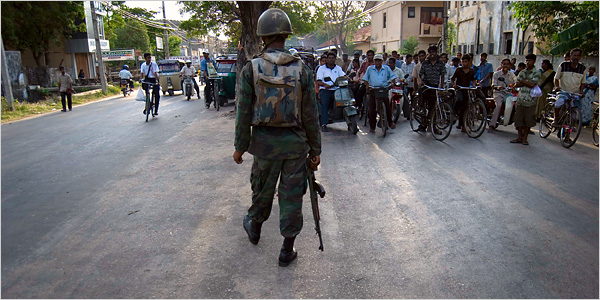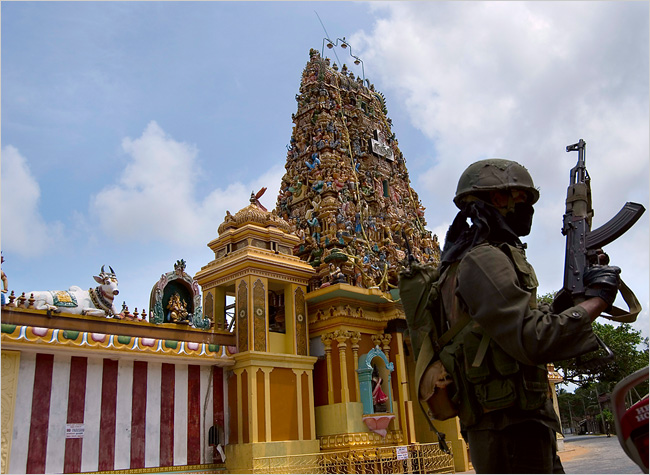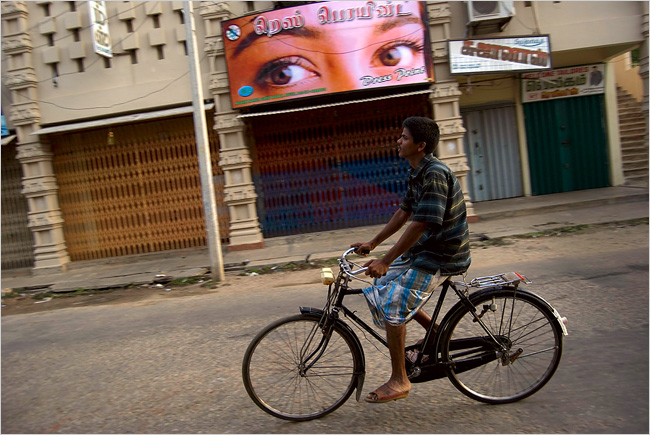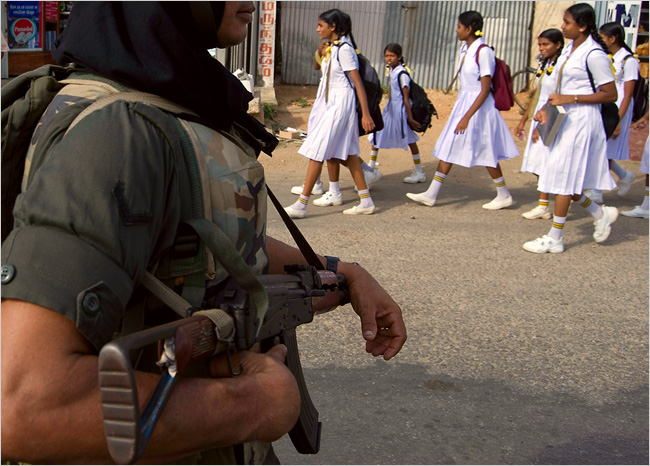Ilankai Tamil Sangam11th Year on the Web Association of Tamils of Sri Lanka in the USA |
||||||||||
 Home Home Archive by Date Archive by Date Archive by Category Archive by Category About the Sangam About the Sangam Engage Congress Engage Congress Multimedia Multimedia Links Links Search This Site Search This SiteEditor Not logged in yet Log in (no unreviewed) |
Sri Lanka's Scars Trace Lines of War Without Endby Somini Sengupta, The New York Times, June 15, 2007
JAFFNA, Sri Lanka — The nights here are once again broken by artillery fire across the black lagoon. The road out of this peninsula has been closed since last August, making the area nearly inaccessible. Though food and fuel manage to arrive, shopkeepers are reluctant to keep stocks, not knowing when they may have to close up and run.
By 7 p.m., barely sundown, stray dogs have the run of Jaffna’s streets. The city’s people are indoors well before an 8 o’clock curfew. Soldiers linger at the edges of the alleys. “Anytime, anything can happen,” said Ravindran Ramanathan, a tailor. “People are afraid of everything.” At least 15,000 are waiting to get on government ships to the relative safety of Colombo, the capital. This is Jaffna, the picturesque prize of Sri Lanka’s ethnic civil war, girding for a new storm. The army commander for the area, Maj. Gen. G. A. Chandrasiri, said he expected a major battle for Jaffna before the August monsoon. No other place in Sri Lanka is so scarred because no place carries Jaffna’s special curse: it is the heart of the homeland that the Tamil Tigers have fought to carve out, and the trophy that soldiers and rebels have fought over for nearly 25 years. A 2002 cease-fire, which had stanched the bloodshed for a time, has collapsed. For a year, fighting has spread across the island between the Sri Lankan military, dominated by the ethnic Sinhalese majority, and the separatist force called the Liberation Tigers of Tamil Eelam. According to the Defense Ministry, more than 4,800 people, civilians and fighters, have been killed since December 2005. Though the number is not entirely reliable, it points to a significantly lethal period even by the standards of this long, ugly war.
It is likely to continue. Peace talks are nowhere on the horizon. Gotabhaya Rajapakse, Sri Lanka’s influential defense secretary, says the military is under instructions to eliminate the rebel leader, Velupillai Prabhakaran, and eradicate his organization once and for all. “That’s our main aim, to destroy the leadership,” Mr. Rajapakse said in an interview in May. The job, he said, would take two to three years. Pressure from abroad has done little to temper either side’s ambitions. The Tamil Tigers, banned in many countries, including the United States, upped the ante this spring by carrying out air raids with modified two-seater propeller planes. Britain and the United States, which extended a hand after the devastating tsunami of December 2004, have suspended aid. Jaffna is no stranger to war. Its temples and churches bear the pockmarks of battles past. Its people are familiar with running and dying. But today the weapons of war are dirtier than ever. Targeted killings and land-mine attacks in crowded civilian areas are common. The Tamil Tigers regularly deploy suicide bombers. Journalists, diplomats and aid workers face hostile scrutiny for any criticism of the security forces. On a Sunday morning in April, a young reporter for a Tamil-language newspaper in Jaffna was shot and killed as he rode his bicycle to work. In May, fliers appeared at Jaffna University, containing a hit list of people accused of being rebel sympathizers. That is not all. A new fear also stalks Jaffna, more ominous than any its people recall from the past: mysterious abductions usually carried out during the curfew hours. No one is quite sure who is being taken, for what reason, by whom. Sometimes, bodies turn up on the street. More often, they do not turn up at all.
One night in early May, well into the curfew, C. Kuharajan’s son, Kanan, 18, was watching television on the floor of his parents’ bedroom, when four armed men pushed open the front door of their house and demanded that Kanan come with them for questioning. His captors refused to identify themselves — “ ‘None of your business,’ ” Kanan’s father recalled them saying. Nor would they explain where they were taking his son or why. The gunmen, all in civilian clothes and with pistols, promised to return him soon. That was on May 4. Kanan, a high school senior, has not been heard from since. According to his family, Kanan had been active in a high school group affiliated with the student union at Jaffna University, which security forces describe as a den of antigovernment activity. But Mr. Kuharajan said his son was under strict instructions to avoid anything political. He said he planned to send Kanan abroad to study next fall. After a month of waiting and searching, Mr. Kuharajan wondered why those who abducted his son did not question him at the house, or at least arrest him and take him to jail. “That’s the terrible thing,” he said, “snatching children from parents’ hands.” The Human Rights Commission, a government agency, said it received 805 complaints of abductions in Jaffna from December 2005 to April 2007; the army says it is aware of 230 abductions. Occasionally, someone survives to tell of the horror. In January, a university student named Arunagirinathan Niruparaj was plucked from his village, taken to what he later identified as a series of military camps and interrogated about links to the rebels. He said his captors hung him upside down from the ceiling and beat his feet. They covered his head with a plastic bag soaked in gasoline. They rammed a stick into his anus. After seven days, they left him on the side of a railway track. By then, he was experiencing kidney failure, one of his ears was damaged and he could not keep down any food. In April, Mr. Niruparaj, 26, fled to Chennai, in southern India. He maintains that he has no links to the rebels. No one has been arrested for his kidnapping.
The reports of abductions have prompted sharp criticism even from Sri Lanka’s allies, including Richard A. Boucher, the assistant secretary of state for South and Central Asian affairs, who met with General Chandrasiri during a visit here in May. In the weeks after Mr. Boucher’s visit, reports of abductions plummeted. General Chandrasiri, in an interview, first said the abductions were the work of pro-government Tamil paramilitary groups who, as he put it, try to “eliminate” Tamil Tiger operatives. He later acknowledged that some people in the security forces could also be involved. “I’m not saying all our people are clean,” he said. “Our duty is to catch them and punish them.” Most of those abducted, he added, are not innocent civilians, but known Tamil Tiger operatives. As for Mr. Kuharajan’s son, the general said he had personally resolved to find him. “I don’t want, internationally, anybody to think every day we are killing people,” he said. Not far from the general’s office, another kind of uncertainty hovers over a Roman Catholic church, now home to a small number of the roughly 300,000 people who have been displaced by the conflict. At this church, some families have fled their homes as many as four times since the war began. The last time was in August, after rebels and soldiers clashed in their village, Allaipiddy, driving its residents into a local church. When it, too, was shelled, a priest, the Rev. Thiruchchelvan Nihal Jim Brown, knelt before the troops and then, waving a white flag, led the villagers here. Days later, Father Brown, who had rebuked the Sri Lankan Navy for attacking the village, disappeared. He has not been heard from since. The families here somehow carry on. The men cannot fish anymore because the coast is occupied by soldiers. Food aid has not come for weeks. Women have sold their gold bangles for rice. Or they have gone without eating, saving what little there is for their children. One mother, Sathyaseelan Thilaka, had been eating so little that she could no longer produce enough breast milk for her youngest child, a 4-month-old boy born in the camp for displaced persons at the church. Mrs. Sathyaseelan, 39, said she had reared four children through this war. Never before had she been without milk. This morning, she sent the older children to school without breakfast. She had eaten nothing herself, and it was almost sundown. An emergency assessment by the United Nations found signs of an increase in child malnutrition in Jaffna. The government has blocked the study’s release. Kavitha Kumar contributed reporting from Bangalore, India. |
|||||||||
|
||||||||||



